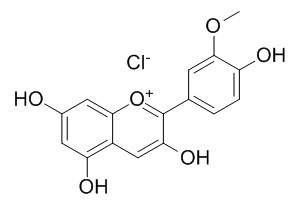Peonidin chloride
Peonidin chloride has antioxidant activity. Peonidin has show potent inhibitory and apoptotic effects on cancer cells in vitro, notably metastatic human breast cancer cells.
Inquire / Order:
manager@chemfaces.com
Technical Inquiries:
service@chemfaces.com
Tel:
+86-27-84237783
Fax:
+86-27-84254680
Address:
1 Building, No. 83, CheCheng Rd., Wuhan Economic and Technological Development Zone, Wuhan, Hubei 430056, PRC
Providing storage is as stated on the product vial and the vial is kept tightly sealed, the product can be stored for up to
24 months(2-8C).
Wherever possible, you should prepare and use solutions on the same day. However, if you need to make up stock solutions in advance, we recommend that you store the solution as aliquots in tightly sealed vials at -20C. Generally, these will be useable for up to two weeks. Before use, and prior to opening the vial we recommend that you allow your product to equilibrate to room temperature for at least 1 hour.
Need more advice on solubility, usage and handling? Please email to: service@chemfaces.com
The packaging of the product may have turned upside down during transportation, resulting in the natural compounds adhering to the neck or cap of the vial. take the vial out of its packaging and gently shake to let the compounds fall to the bottom of the vial. for liquid products, centrifuge at 200-500 RPM to gather the liquid at the bottom of the vial. try to avoid loss or contamination during handling.
J of Applied Biological Chem.2020, 63(2):147-152
Pharmaceuticals (Basel).2024, 17(6):727.
Front Plant Sci.2021, 12: 648426.
J Traditional Thai Medical Res.2022, 8(1):pp1-14.
Kaohsiung J Med Sci.2024, 40(3):280-290.
Pharmacogn Mag.2015, 11(43):562-6
The Journal of Korean Medicine2022, 43(3): 79-93.
Antioxidants (Basel).2021, 10(10):1620.
Antioxidants.2022, 11(3):592.
J Chem Inf Model.2021, 61(11):5708-5718.
Related and Featured Products
American Society of Plant Biologists Annual Meeting.2004.
Methylation of an anthocyanin increases its ability to inhibit growth of corn earworm larvae.[Reference:
WebLink]
The anthocyanins are synthesized by flowers primarily to attract pollinators and seed dispersers. A few studies have determined that some anthocyanin compounds, such as cyanidin 3-ß-glucoside, can reduce insect feeding. Our objective was to determine if this activity could be extended to an insect pest of corn.
METHODS AND RESULTS:
Purified cyanidin chloride did not inhibit the growth of corn earworm (CEW) larvae at 1000 ppm in insect diet, but purified Peonidin chloride significantly reduced the growth of the larvae at the same concentration. Peonidin has the same structure as cyanidin except that its 3'-hydroxyl group is methylated. In order to confirm these findings, we also tested plant materials that contain cyanidin and peonidin type anthocyanins. We excised colored and white sectors from striped petunia flowers and fed them separately to CEW larvae. After 2 days of feeding, the CEW larvae fed significantly less on the colored sectors compared to the white sectors. The reduction in feeding rates was greater in colored sectors containing peonidin type anthocyanins compared to those containing cyanidin type anthocyanins.
CONCLUSIONS:
Together these results indicate that expression of relevant anthocyanin molecules at suitable levels in corn may be an effective means to reduce CEW predation of plant tissues.



